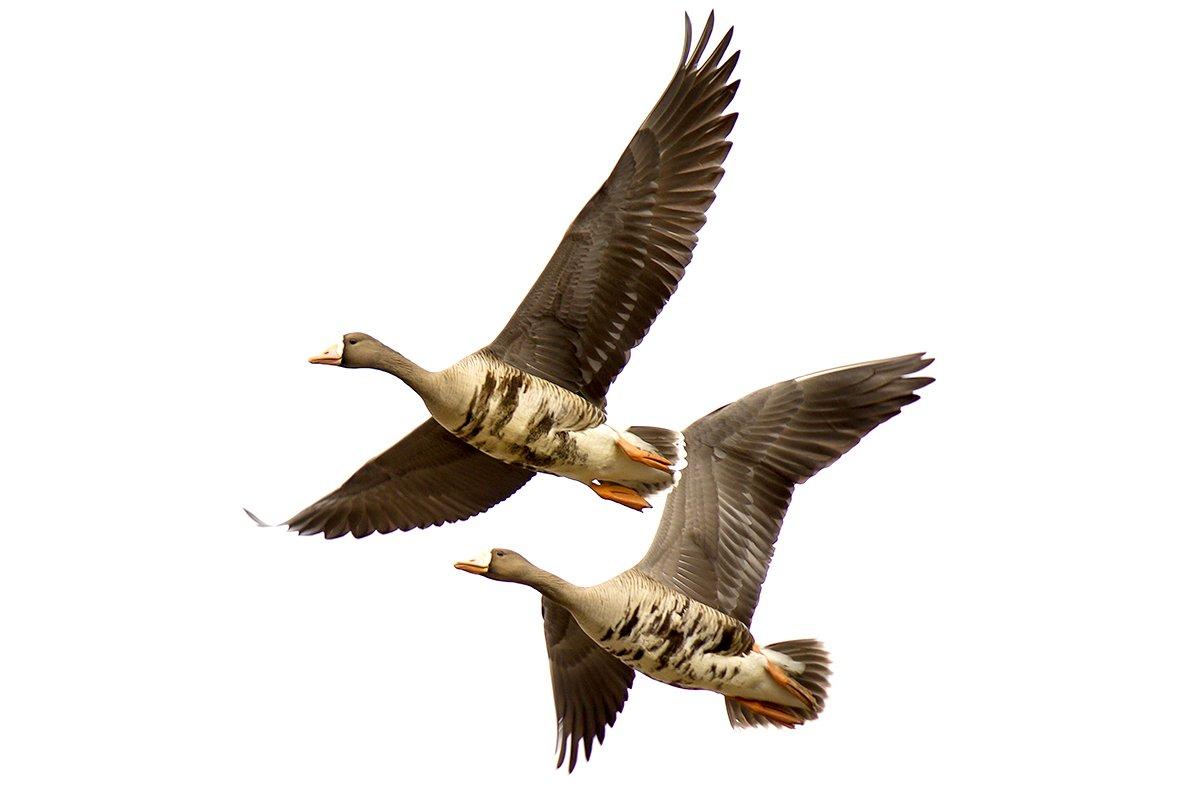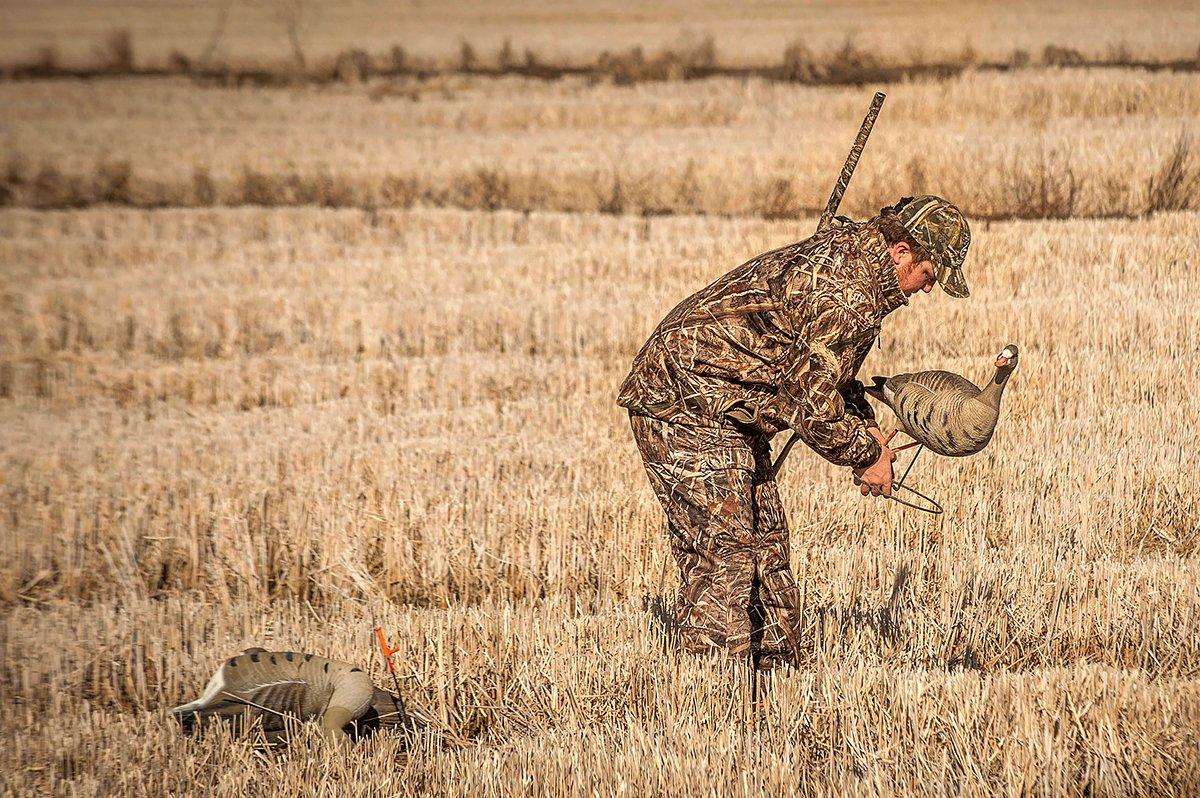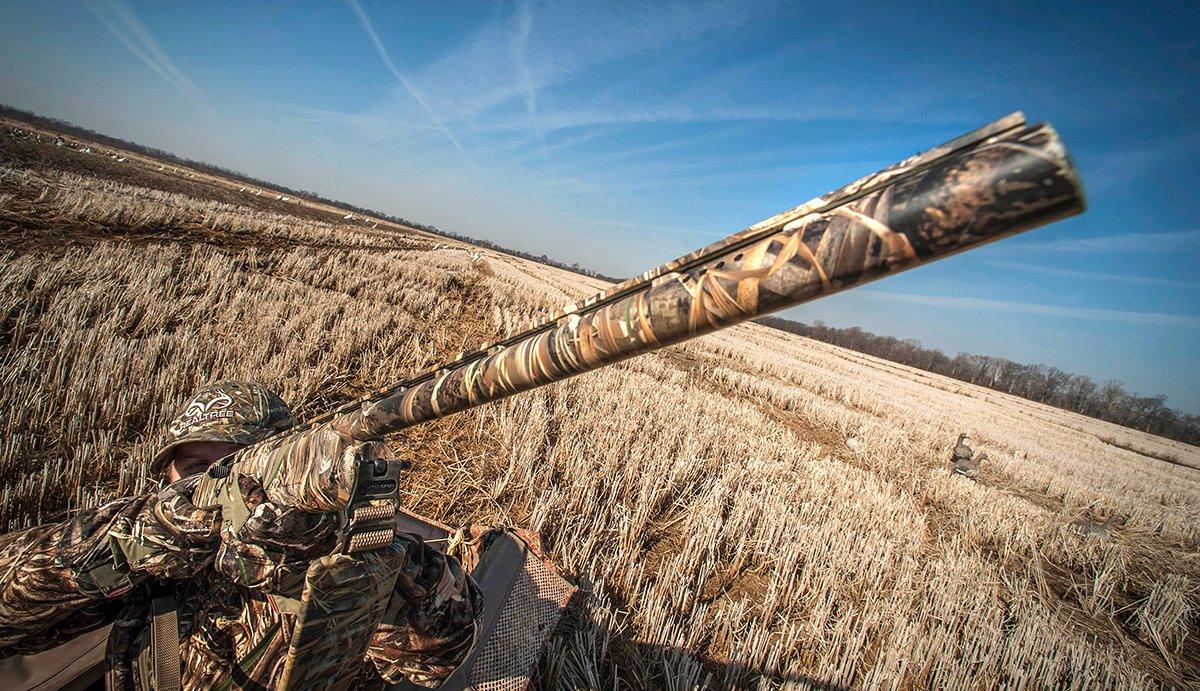White-fronts seem to be more common nowadays, but many hunters haven't adapted their tactics to take advantage. Here's how an expert puts more specks on his strap
White-fronted geese and snow geese have experienced a population boom the past few decades. Dark geese are seen less frequently in the southern reaches of flyways — debatably from warming winters, changing agricultural practices or a combination of those factors — but specks and snows saturate the skies where Canadas once ruled.
Despite the increase in numbers, many hunters have failed to adjust their tactics and strategies to take advantage of the mushrooming opportunity. Only a few heyday Canada goose hunters have switched sides and chase specks with as much enthusiasm as they had for pursuing dark geese in the good ol' days. Most have switched to ducks or still grind it out in search of waning flights of honkers.
Specklebellies and Canadas are different species, however, and although some behavioral characteristics overlap, they should be treated and targeted individually. To geese, Kelley Powers is public enemy No. 1. The former World Goose Calling Champion of Champions winner and co-founder of Power Calls and Final Flight Outfitters has made it his mission to uncover the secrets to speck hunting. He has traversed the flyways putting specklebellies in the crosshairs, and the Power Calls team has developed two speck calls from scratch. It's safe to say he's an expert. Powers recently shared four tips for putting more barbellies on the stringer.
Specialize on Specks
North America winters three and sometimes four subspecies of specklebellies — the fourth being rare sightings along the East Coast of birds migrating from Greenland. The largest population seen along the Central and Mississippi flyways breeds on the tundra of northern Canada and concentrates in southern portions of the Central Flyway, the lower Mississippi watershed and along the Texas coast. Conversely, the Pacific Flyway winters white-fronted geese that summer in the coldest parts of Alaska.
With so much diversity of habitat, specks have developed unique preferences that, according to Powers, require specialization.
I was hunting in Canada in the early 2000s, and there were a lot of specks in the area, he said. We were hunting over a decoy spread of about 200 Canada goose decoys. Specklebellies would come close but wouldn't commit. When hunting specks, you have to be committed to hunting specks.
Powers said he'll mix duck and honker decoys to some degree when pursuing both species. However, you cannot do that with specks.
In the wild, they like to be off on their own, he said. They can be very temperamental and don't like to mix and mingle with other types of waterfowl. If you mix your speck decoys with ducks or other types of geese, it won't look natural.
If you want to hunt ducks, Canadas and specks all together, put your duck decoys and Canada goose decoys together. Then put your specklebelly decoys in a completely separate part of your spread. If you're hunting in a pit or a blind where you can shoot to the back, put your duck decoys and Canada goose decoys in front of the blind and your speck decoys behind it. If you're really serious about killing specks, you need to focus on them instead of trying to play all hands. Although it can be done, they can very quickly turn away if they don't like your mixed spread.
(Don't Miss: Duck Dinner in 30 Minutes)
Call the Right Way
Specks are one of the most vocal waterfowl, and calling is an effective tool for them. In many cases, callers interact with lead geese in a conversational way. Powers said to learn the call types and be strategic when deploying them.
The main parts of a specklebelly call are the cluck and the yodel, he said. A specklebelly cluck sounds like a Canada goose cluck — a quick burst of air that starts deep and rolls high. With a duck call, everything revolves around a quack, and a Canada goose calling sequence is a series of clucks or honks. Likewise, when calling specks, the cluck is the first note to learn. Hunters should take that sound and build a calling sequence from there.
A yodel is a sequence of clucks geese make when they're together, Powers said.
Often, you hear a two- or three-note yodel when geese are flying, and it's good to trade yodels with working geese, he said. When calling to birds in the air, make sure to match your calling sequence to your decoy spread. For instance, if you're hunting with a small group of decoys, call like a small group of geese. If you're using a large decoy spread, make sure you call enough. Lots of murmuring and some progressive clucks can simulate larger groups of geese on the ground.
Powers said his best calling tip is to first catch a goose's attention.
Mix in some calling and flagging to make them aware of your decoy spread, but then don't be afraid to stop calling directly to them and let your decoys do the work, he said. Weather is also a huge factor. If it's calm without a lot of wind, you have to tone down your calling, or else they will pinpoint your location and flare. Some days, you need to call them right into the decoys, but on others, calling less can be the teaser they need.
(Don't Miss: Advanced Tips for DIY Green Timber Duck Hunting)
Cut Down Your Decoy Spread
I have a love-hate relationship with specks, Powers said. There's a very steep learning curve to hunting them, and they can be very finicky. So many variables come into play to get them on the ground.
He's right. White-fronted geese are extremely exciting to hunt, and they make great table fare — maybe the best of all waterfowl. They can also be frustrating. What works in one place is no guarantee in others.
On another hunt, Powers said, we went from Canada to Louisiana, and my friend was hunting them differently than we hunted them just a few weeks before in Alberta. We were using larger, more traditional goose spreads, but in Louisiana, my buddy was only putting out five decoys. He would throw them out in a field or pond and hide in a ditch nearby. Completely different approach.
In hindsight, however, the strategy made sense.
They are a lot smarter than we realize and a lot more wary, too, Powers said. By the time they reach the southern end of a flyway, they've seen a lot of hunting pressure. Sometimes, it takes a different approach to lure them into shooting range. If they're used to seeing big spreads from Canada to Arkansas, why not give them something different — something they haven't seen before.
Powers said a smaller decoy spread — not just when hunting specks but with all waterfowl — can be a secret weapon at times.
Your decoy spread doesn't have to become a numbers game, he said. Make sure you buy high-quality decoys. Start with one dozen, and try dedicating yourself to hunting specks and specks only. You'll have a higher chance of success. Larger spreads can work too, but make sure to move the decoys around periodically in case you aren't getting new birds.
(Don't Miss: Should You Lease That Duck Field?)
Perfect Your Hide
No duck or goose setup will work if hunters aren't properly hidden, and geese are especially cagy. In many cases, they'll hit the centers of dry fields, where hiding is almost impossible.
Any time you can use natural cover, it's obviously better, Powers said. If you just stick a panel blind in the middle of a field, they'll never come into shooting range. If you can't set your decoys close to natural cover, put your decoys in the middle of the field and try to pass-shoot geese while hiding in the field edges. Geese will always land into the wind, so put your decoys in a part of the field where you can hide downwind under their approach. Shot opportunities will come when they make their turn to setup for the landing. They'll never suspect you're hiding there and will instead focus their attention on the decoys.
Powers said geese typically like to feed in plowed fields where they can find food in fresh dirt. They also prefer shallow, muddy places instead of deeper water. Those types of places are difficult spots to hide.
If geese are already coming toward you and you're hunting in those conditions, let them keep coming, and be completely still, he said. Keep the call in your pocket, and let an approaching bird approach. Their eyesight is impeccable, and they'll see movement from a long way away, even if it's just a hunter putting the call up to their mouth. Plus, calling is your trump card. Don't play that card until you have to.
(Don't Miss: Realtree MAX-7 is Our Most Effective Open-Country Waterfowl Pattern Yet)











